Introduction
The Granada Geopark extends over an exceptional territory in Eastern Andalusia, in southern Spain. The Geopark territory is 4,722 km2 in areas, and includes 47 municipalities of Guadix, Baza, Huéscar and Montes. Topographically, it encompasses a region of river valleys generated during the Quaternary, as well as much of the basin from Guadix-Baza and part of the mountains that delimit it. The network of riverbeds comprises an arid and very rugged landscape with badlands as its outstanding feature, and which includes canyons up to 250 m deep, and the fluvial terraces of the main rivers form alluvial plains, which are known as vegas in this region. This territory has been known traditionally as the depressions or “basins” of Guadix and Baza. The area is noted for its geology, geomorphology, archaeology, and cultural legacy, including some of the oldest human remains in Europe.
The valleys north of Granada drain towards the Atlantic Ocean and were created by river erosion in the last half million years. Prior to their formation, and lasting for approximately 5 myr, most of the territory of the Geopark was formed by a large river system that drained into a large lake, but without exit to the sea. This endorheic stage favored one of the best Quaternary sedimentary records in continental Europe. The semi-arid nature of the region, with sparse vegetation on the valley slopes, makes it easy for the geologist to observe one of the best Quaternary sedimentary successions, arranged in horizontal strata of great lateral continuity.
Scientific research in the Granada Geopark dates back to the first half of the 18th century. The first geological monograph on the territory was written by Leo Sieger (1905) and his title was “The Guadix-Baza basin”. But it was from the 1970s when research was intensified in the territory due to the discovery of some macrovertebrate fossil sites that cover the entire lower Pleistocene. The oldest human fossil remains of Western Europe appeared in these sites. In addition, there have been intensive studies of stratigraphy and sedimentology, geomorphology and tectonics of the territory (e.g., Sanz de Galdeano 1992; Viseras & Fernández 1992; Fernández et al. 1993, 1996a, 1996b; Viseras & Fernández 1995; Soria 1998; Soria et al. 1998; Soria et al. 1999; García-García 2006; Soria & Viseras 2008).
Geoconservation and Future Aims
Responsibility for the management and coordination of the proposed Geopark lies with the Granada Geopark Project Coordinating Committee, made up of representatives of the institutional, socio-economic and scientific agents involved in the project, through an agreement signed on 07 November 2017. The committee is chaired by the President of the Provincial Council of Granada, with the aim is to be inscribed in the UNESCO Global Geoparks Network, which was achieved in 2020.
Over the past 100 years of research in the Granada Geopark region by dozens of paleontologists, some 200 paleontological sites containing the remains of vertebrates have been identified in the Granada Geopark. However, only a few have been catalogued as part of the Spanish geological heritage and given the designation Site of Geological Interest (Spanish acronym LIG) based on their significance within the Granada Geopark or internationally, according to the Natural Heritage and Biodiversity Law (Law 42/2007).
La Estación Paleontológica Valle del Río Fardes (The Valle del Río Fardes Paleontological Station), in Fonelas, is a paleontological museum that shows what the area was like two million years ago: giraffes, rhinoceroses, hyenas, mammoths, saber-toothed tigers and cheetahs have all been found, and they are on display. The Museum is a much-visited tourist site and widely advertised for international holidaymakers.
Here, we focus on the most significant paleontological sites with mammal records in the Granada Geopark (Fig. 1), ranging in age from the end of the Miocene when the region was a marine basin via a delta to the continental endoreic basin of the Pleistocene. In the listings below, the official site numbers (LIG) and site names are given. There are many publications on the mammals (e.g., Sesé 1989; Luzón et al. 2020) and the earliest remains of European humans (e.g., Toro-Mogano et al. 2013; Sala 2015).
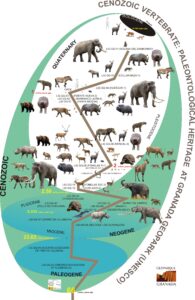
Figure 1. Diagram showing the vertebrate paleontological heritage in Granada Geopark (GG). It also shows the other Cenozoic Era LIGs (paleontology, marine invertebrates) catalogued to date (22, 49, 28, 27).
Neogene: Upper Pliocene (Ruscinian)
Negratín-Delf paleontological set (LIG GG-13; Cuevas del Campo): a set of sedimentary units showing an ancient delta where it met the sea, dating from the Lower Pliocene (Ruscinian, 5.3–3.5 Ma). There are abundant sandstone layers in the intertidal zone containing numerous fossils of brachiopods, barnacles and bivalves (including Pectinidae and Ostreidae); interspersed with mixed continental/supratidal units containing vertebrate fossils, both terrestrial, such as pigs and the Dicerorhinus megarhinus rhinoceros (or Dihoplus megarhinus), and marine, with dolphin vertebrae and jaw fragments.
Baza-1 (LIG GG-43; Baza): site located on the edge of an ancient marsh area, dating from the Lower Pliocene (Ruscinian; c. 4.5–4.0 Ma), where diverse fossils have been excavated, including some that indicate the co-existence of two proboscideans of the mastodon group: Anancus arvernensis and Mammut borsoni (or Zygolophodon borsoni).
Darro karstic site (LIG GG-12; Darro): paleontological site dating from the Upper Pliocene (3.5–3.2 Ma), formed inside a vertical karstic fill. It contains abundant remains of micro-mammals (primarily rodent bones and teeth). Micro-vertebrates were caught and eaten by birds of prey and, over time, introduced as pellets into cracks in the external surfaces of the karst. Here and there, fossilized bones from small land turtles, monitor lizards (subtropical climate conditions) and Cercopithedicae primates (Paradolichopithecus, animals similar to today’s African mandrills and baboons), originally introduced inside the cavity by gravity.
Tollo de Chiclana palaeontological set (LIG GG-47; Gorafe-Negratín (Freila)): a complete set of continental units from the Pliocene offering an extensive and diverse record, in terms of chronology and taxonomy, of continental micro-mammals (rodents and insectivores, including a new type of primitive desman, an amphibious mole). This set is moreover important because the series of sites reveals a major change in rodent fauna occurring around 3.5 Ma, almost certainly the origin of today’s rodent fauna from this group in Europe. This set is mainly of international scientific importance.
Quaternary
Huélago-C (LIG GG-15, Huélago): paleontological site from the Lower Pleistocene (c. 2.5 Ma). It contains fossils of the first known zebra population to inhabit the basin (Equus livenzovensis), monodactyl equids that arrived from North America and crossed Asia to definitively supersede primitive tridactyl equids (Hipparion) in European ecosystems.
Fonelas SCC-3 (LIG GG-10; Fonelas, paleo-river zone): dated as 2.5–2.4 Ma by magnetostratigraphic means (start of the Quaternary). This site contains only megafaunal remains, teeth of the last mastodons that inhabited Europe (Anancus arvernensis mencalensis; the most recent and smallest-size specimens of this species) discovered along with teeth from the first mammoths (Mammuthus meridionalis) to arrive in the Iberian Peninsula (from North America and across Asia). Both types of proboscideans, mastodons and mammoths, coexisted at this site, indicating the extinction of the first and the start of the evolutionary success of the second throughout the Lower Pleistocene in Europe.
Fuente Nueva-1 (Orce, paleo-lake region): a small continental outcrop dating back 2.5–2.1 Ma (Quaternary, Lower Pleistocene) containing the remains of a single species of zebra, spiral-horned antelopes and, interestingly, abundant cranial remains of a species of gazelle (Gazella borbonica) that became extinct in Western Europe around 2.1 Ma. In terms of this faunal group, abundance of Gazella borbonica cranial remains and chronology (2.1 Ma old as very recent or older), this site is similar to the one in Fonelas nominated as Fonelas ST-1.
Fonelas P-1 [LIG GG-08, Geosite VP014 - Natural Heritage and Biodiversity Law (Law 42/2007); Fonelas, IGME Fardes River Valley Palaeontological Station, Geological Reserve, protected site, National Heritage]: Fonelas P-1 paleontological site, dated as 2 Ma by magnetostratigraphy and biostratigraphy, shows the conservation of a den/feeding area used by giant short-faced hyenas (Pachycrocuta brevirostris) inhabiting the dried floodplain area of the large Fardes paleo-river. Fonelas P-1 was home to 24 species of large mammals including equids (zebras, represented by a single large species) and a large reptile species. This site provides a record of the coexistence of autochthonous European fauna and incoming fauna from Africa and Asia. Other unique features are: different species and sub-species of large mammals hitherto unknown to science, the largest known collection of spiral-horned antelope (Gazellospira torticornis hispanica), the first European wolf population (Canis etruscus), the first Iberian Lynx population on the Iberian Peninsula, the first mountain goat population in the world (Capra baetica), the only populations of brown hyena and river boar outside Africa, the most recent Iberian population of Paleotragus giraffids and the last known European population of Titanochelon genus giant turtles. That this turtle is present in such recent sediments (the genus was thought to have become extinct around 3.3 Ma), indicates that the climate was still subtropical in the Guadix-Baza basin two million years ago, when around 2.5 Ma intense glaciation was taking place in the northern hemisphere. The site is the type locality of different newly discovered species and varieties of extinct mammals and extends in a north-easterly direction for several kilometers when its technical denomination becomes Fonelas SCC-1. In sum, this site represents a Quaternary (Lower Pleistocene baseline) ecosystem never previously identified on the European continent, the precursor structuring the community of large mammals that developed in Europe over a period spanning 2.0 Ma to 900,000 years ago.
Mencal-9 (LIG GG-09; Villanueva de la Torres): a paleontological site dating from 1.7–1.5 Ma (magnetostratigraphic analysis) formed in a dried-up marsh system. On this site, skeletal remains were concentrated through a gradual process of attrition whereby mammal bones were buried underground slowly after decades of exposure to weather and sunshine (extreme weathering due to exposure to sunlight). There is a fossil record of: Pannonictis nestii, Canis etruscus, Pachycrocuta brevirostris, Capra sp., Antilopinae indet. cf. Gazellospira sp., Bovidae gen indet., Leptobos etruscus, Cervidae gen. indet., Hippopotamus sp., Equus cf. altidens, Stephanorhinus etruscus and Mammuthus meridionalis. This site is home to the oldest known population of hippopotami on the Iberian Peninsula.
Huéscar-1 (LIG GG-64, Geosite VP018, part of the LIG nominated as Paleontological set comprising Barranco de las Cañadas, Barranco de las Quebradas, Cortijo de la Calahorra; Huéscar): a paleontological site in which fossil remains are associated with a system of river deltas flowing into a lacustrine area. The bones show numerous marks of abrasion and dragging. The mammal fauna here enable it to be dated to the upper part of the Lower Pleistocene, around 0.95–0.83 Ma. The faunal inventory for this site, including two equid species: Equus altidens and Equus suessenbornensis, is similar to those identified at Barranco León-5 and Fuente Nueva-3. Its fossil record shows a proboscidean that was recently reassigned to Mammuthus meridionalis, indicating that Huéscar-1 was home to one of the last populations of this mammoth prior to its extinction. Evidence of stone tool industries have been found on this site.
Cúllar-Baza-1 (LIG GG-57, Geosite VP019; Cúllar, SCI: Archaeological Zone): paleontological site of marsh origin with an assemblage of large mammal fossils slightly more recent than Huéscar-1 (possibly towards the end of the Lower Pleistocene, c. 0.8–0.7 Ma). The proboscidean identified in this instance is Mammuthus trogontherii, more recent than M. meridionalis. Again, the two equids mentioned above coexisted here, and there is also evidence of sporadic stone industries.
Solana del Zamborino (LIG GG-11, Geosite VP020; Fonelas, SCI: Archeological Zone): Solana del Zamborino is an outdoor anthropic site formed in a lake-marsh environment that must date from the Middle Pleistocene, given that all the vertebrates are characteristic of that age in Europe (i.e., 0.781–0.126 Ma). The proboscidean identified is Elephas antiquus, the equid is Equus caballus torralbae, and in addition the fossils of macaques have been discovered. Evidence of Acheulian stone tool industries have been found at this site.
Pleistocene Sites with Earliest Records of Humans in Europe
Three sites around Orce (Venta Micena, Barranco León-5, Fuente Nueva-3) record the earliest presence of humans on the Iberian Peninsula. The age of these sites is the subject of debate. Although some publications have suggested that Venta Micena dates back 1.5 Ma, Barranco León-5 1.4 Ma and Fuente Nueva-3 1.3 Ma, the large mammal faunas identified in the three locations are similar to each other and characteristic of the Epivillafranchian age (i.e., the period spanning 1.2–0.9 Ma; like the Untermassfeld site in Germany). There are in fact geological data relating to a sedimentary break, indicating that these three sites could be strictly contemporaneous. The three sites taken together as a whole are an exceptional source of information for the paleoenvironmental reconstruction of this time and the particular ecosystem. Further details of each of these three geosites are given.
Venta Micena (LIG GG-61, Geosite VP015; SCI: Archaeological Zone): comprises a vast accumulation of bones produced by a pack of Pachycrocuta brevirostris hyenas in their den and feeding ground, located outdoors on the dried-up shores of a lacustrine area devoid of vegetation. The site contains a diverse community of extinct mammals, including derived wolves (Canis mosbachensis), hippopotami, feral dogs, some bovids of Asian origin and a single derivative species of zebra (Equus altidens granatensis). Using the scientific collection from this site, an internationally significant model for the feeding habits and paleo-ethology of giant short-faced hyenas has been established. The site is the type locality of diverse new species and varieties of extinct mammals. This is the reference site for early human occupation of Europe, given the diversity of species identified, and it sheds light on the ecosystem in which hominins inhabited the Iberian Peninsula around or after 1.2 Ma.
Barranco León-5 (LIG GG-62, Geosite VP16; SCI: Archaeological Zone): located on an ancient deposit left by a river spate (arriving from nearby mountains with carbonate rocks dating from the Jurassic Period) in an erosive paleo-surface developed on a previously dry paleo-marsh. Other than the hippopotami fossils, its paleontological and archeological record are reworked. There are numerous examples of hominin Oldowan lithic industries. This site is significant in that two human fossils were discovered here (two milk teeth, one of which fragmented) belonging to a child aged approximately 10 years old. It also contains the fossils of two equid species: an evolved zebra (Equus altidens) and a primitive horse (Equus suessenbornensis).
Fuente Nueva-3 (LIG GG-63, Geosite VP17; SCI: Archaeological Zone, site protected with a roof): a site initially formed on the edge of a marsh with moderate vegetation cover. Its lower calcareous horizon (micritic) can be correlated with the white layers in Venta Micena (sedimentary break). The upper horizons feature a number of pronounced deformations, possibly caused by megafaunal bioturbation and/or post-deposit processes relating to seismic activity. This site contains abundant bone fossils from hippopotami and mammoths (Mammuthus meridionalis). In terms of taphonomy, the scattered bones of an almost complete skeleton of this type of proboscidean have been unearthed in one of the upper levels of Fuente Nueva-3, surrounded by giant hyena (P. brevirostris) coprolites, along with the remains of anthropic lithic artifacts (Oldowan stone industries). Once again, the faunal group reveals the coexistence of two equids: an evolved zebra (Equus altidens) and a primitive horse (Equus suessenbornensis).
Significant Milestones in Mammal Evolution
We round off this presentation of the vertebrate paleontological heritage of Granada Geopark by listing the most significant milestones in the evolution of mammals recorded in the Geopark (see Fig. 1):
- Transition from marine to continental ecosystem (5.3–3.5 Ma): the concentration on beaches on a delta of the remains of primitive rhinoceroses and dolphins (LIG GG-13) in Cuevas del Campo. These fossils of river or sea dolphins (yet to be established) are the only known cetaceans in the Guadix-Baza basin.
- Coexistence of two species of mastodons (Anancus arvernensis and Mammut borsoni), around 4.5–4.0 Ma in Baza. (LIG GG-43).
- The first old world monkeys inhabiting the Geopark around 3.5–3.2 Ma (LIG GG-12) in Darro.
- New species of small mammals during the Pliocene (LIG GG-47) in Gorafe and Freila.
- The arrival of the first zebras (Equus livenzovensis) from Asia, 2.5 Ma (LIG GG-15) in Huélago.
- The arrival of the first mammoths (Mammuthus meridionalis) from Asia, which coexisted with the last autochthonous European mastodons (Anancus arvernensis mencalensis) 2.5–2.4 Ma (LIG GG-10) in Fonelas. Mastodons became extinct.
- Novel European ecosystem (“biodiversity hotspot”), 2.0 Ma: Fonelas P-1 (LIG GG-08). The first wolves, giant hyenas, mountain goats and the last giraffes and giant land turtles in Europe.
- The first population of hippopotami on the Iberian Peninsula, 1.7–1.5 Ma (LIG GG-9) in Villanueva de las Torres.
- The forebears of human populations and information on the paleoenvironmental context in which they lived, approx. 1.1 ± 0.2 Ma (Venta Micena LIG GG-61, Barranco León-5 LIG GG-62 and Fuente Nueva-3 LIG GG-63) in Orce.
- The arrival (?) in Huéscar of the first horses in the strictest sense of the term (Equus suessenbornensis), also from Asia, approximately 900,000 years ago (LIG GG-64). This species is also recorded from Barranco Léon-5 and Fuente Nueva-3. Depending on their definitive chronologies, this question may vary in terms of location and/or chronology.
- The last mammoths in the Geopark, at the start of the Middle Pleistocene (LIG GG-57) in Cúllar.
- Macaques inhabiting the region (Macaca sylvanus) coexisted with the first elephants s. during the Middle Pleistocene (0.78–0.126 Ma) (LIG GG-11) in Fonelas.
The Fonelas P-1 Palaeontological Site, Geoconservation and Public Valorization
As we have seen, the Fonelas P-1 site is unique in many ways (Fig. 2), and as a result it has been the focus of geoconservation efforts. The site was discovered in 2000, and in 2001, IGME launched a full research program and its regional geological context in the Guadix-Baza depression.
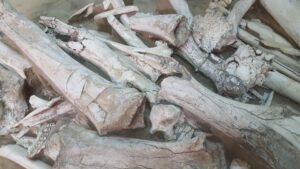
Figure 2. Set of fossilized bones characteristic of Fonelas P-1, mainly Gazellospira and Metacervoceros cranial remains and long bones, of particular interest being those belonging to young Mammuthus, all showing signs of partial consumption by Pachycrocuta brevirostris hyenas.
In 2007, Fonelas P-1 was listed as a Geosite (Global Geosites Project Spain; Natural Heritage and Biodiversity Law (Law 42/2007)), and in 2010, as a cultural geo-resource by the Regional Government of Andalusia (Andalusian strategy for comprehensive management of geo-diversity). On 28 December 2010, IGME purchased the 25 ha where the site is located, thus affording it the highest level of protection. In September 2011, IGME approved funding for a new stage of research and publicity for the Fonelas P-1 site and the Fardes River Valley Palaeontological Station (Spanish acronym EPVRF: Estación paleontológica Valle del río Fardes) was established, with appropriate financial and technical support for diverse activities over the following years (IGME EPVRF Task Force, comprising 26 experts in Earth Sciences, Life Sciences, geological heritage and publicity) to develop the first stage of the scientific fieldwork project: Fonelas P-1 Paleontological Centre (CPFP-1).
Through the IGME project, in 2012 the upper part of the site was prepared by earthworks (1174 cubic meters of sterile rock removed above the fossil-bearing unit, 927 m ASL), an enclosure was installed for protection from geological risks, a works plan was drawn up and technical, scientific and power supply equipment was procured to equip what would become CPFP-1.
Grant funding of € 460,793.51 was also applied for from the Granada Province Cooperation Group to build the Fonelas P-1 Palaeontological Centre, the first stage of EPVRF development. On 19 December 2012, the entire grant was approved to build a protective roof, enclosure and walls over part of the Fonelas P-1 excavation site. This grant was approved by the Granada Province Cooperation Group (Directorate-General for Sustainable Rural Development) in the category Protection and Conservation of Cultural Heritage and was co-funded by the European Regional Development Fund and the Regional Government of Andalusia.
The infrastructure created with this funding, built during 2013, is the Fonelas P-1 Paleontological Center (a 1020 m2 protected area), the first stage of the Fardes River Valley Paleontological Station. This enabled protection of the site from atmospheric and biological damage, and its palaeontological heritage to be safeguarded. Systematic works then proceeded so that the fossils obtained could be analyzed in situ. Stratigraphic sections were conserved to enable appropriate 3D interpretation of the processes that formed the site, as well as to collect materials for research and display in a museum.
In 2014, IGME (EPVRF) selected, collected and funded items for display in the Paleontological Center, with a budget of € 200,000, and the center was opened to the public by appointment. In 2016, Fonelas P1 was listed as a Granada Geopark LIG, and in 2017, fieldwork staff were appointed (senior technical expert) and the Center opened to the public all year round. In 2020, Granada Geopark joined the UNESCO Global Geoparks Network.
The Fardes River Valley Paleontological Station is thus a field infrastructure owned by the Spanish Geological Survey (IGME), where research, dissemination and teaching activities are organized around the large mammal site in Fonelas P-1 at the start of the Pleistocene. Its main function is study, research, dissemination and teaching activities (Fig. 3), in the fields of paleontology, taphonomy, paleoecology, paleoclimatology, stratigraphy and sedimentology.
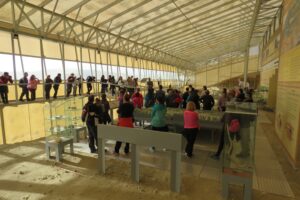
Figure 3. A guided visit to the Fonelas P-1 Paleontological Center (Fardes River Valley Paleontological Station). Between March 2017, when it was definitively opened to the public, and the same month in 2020 (covid-19 crisis) more than 10,000 people visited the paleontological site and this geological reserve.
Studies, inventories and dissemination are also carried out on current flora and fauna found in the semi-desert areas of the Guadix Basin. They focus on their presence and distribution in this National Geological Reserve, EPVRF. The ultimate aim of this public service initiative is to promote rural development through research, which in turn feeds both dissemination and teaching (I+3D), in the framework of the Fardes River Valley Palaeontological Station.
In formal terms, the Fonelas P-1 is documented according to the Geosite code VP014 in context of the Plio-Pleistocene vertebrate sites of Spain, according to Natural Heritage and Biodiversity Law 42/2007. It is also scheduled as a geosite for its geological structures and formations of Cenozoic continental and marine basins. It has LIG code AND303 (Andalusian strategy for comprehensive management of geo-diversity, Regional Ministry of the Environment, 2010), and the LIG code for Granada Geopark (UNESCO 2020) is LIG GG-08. It is owned by the Instituto Geológico y Minero de España, Ministry of Science and Innovation (National Heritage), and the IGME unit is the Fardes River Valley Palaeontological Station (EPVRF).
In summary, the elements of geological heritage for Fonelas P-1 are palaeontological (40 extinct species of vertebrates, among which 25 large mammal species; Figs. 4–6), stratigraphic, sedimentological, and geomorphological. The biological heritage includes populations of endemic botanical species at critical risk of extinction (Clypeola eriocarpa and Limonium majus), with a provisional inventory of 486 species of animals (among which 404 invertebrate species) and 297 species of plants. Archeological heritage includes prehistoric dolmens.
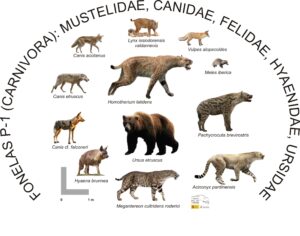
Figure 4. Fonelas P-1 Carnivora diversity. The site contains the oldest European populations of Pachycrocuta brevirostris and Canis etruscus. It features new species of jackals and badgers and the only known population outside of Africa of the brown hyena.
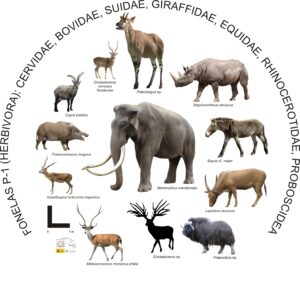
Figure 5. Fonelas P-1 Herbivora diversity. The record of Paleotragus, Praeovibos, the river warthog and the oldest population in the world of mountain goat stand out.
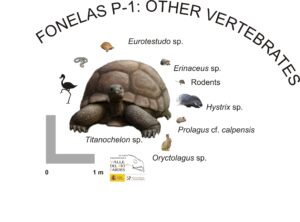
Figure 6. Fonelas P-1 micromammals and other vertebrates. Among the reptiles, the presence of giant tortoises stands out. Fonelas P-1 has the last known population of the lineage, which was assumed to be extinct in Western Europe 3.3 million years ago.
Infrastructure relating to the geopark includes the Fonelas P-1 Paleontological Center, and the protected site of same name, monitored and displayed in a 1020 m2 area. This includes the History of the Earth and Life on Earth dissemination modules. There is an EPVRF geological field route, 1 km long. In addition, there is the fieldwork building over part of the fossiliferous site, equipped with a renewable energy system. The site is open for visits all year round, with free entry, and further information is at: http://www.igme.es/epvrf/estacion and
https://www.geoparquedegranada.com/.
Acknowledgments
We thank Dan Grigorescu for the invitation to contribute.
Conflict of Interest
The authors have no known conflict of interest.
